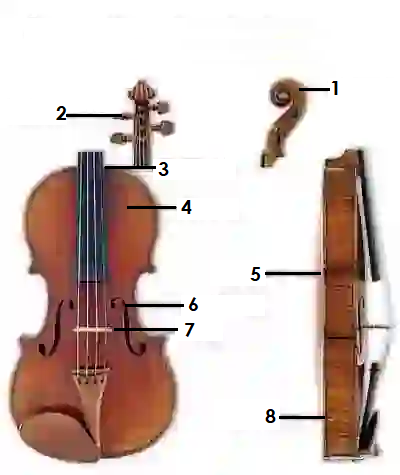Construction and function of the violin - Philipp Dangas
Construction and function of the violin
The neck has a length of approx. 13 cm and the fretboard is approx. 27 cm long, which protrudes approx. 14 cm over the body (approx. 35 - 36 cm). The (upper) saddle at the upper end of the fingerboard, over which the strings run into the peg box to the pegs, are used to tune the strings. The snail at the end of the neck, often a distinguishing feature of a good violin maker due to its special design.
The corpus: The soundboard is the F-hole shaped, arched top section made of spruce, almost always in two halves glued together in the middle. The ceiling works as a vibrating membrane, comparable to that of a loudspeaker.
The back is usually made of maple, also arched, but in contrast to the top sometimes made of just one piece, which can be seen very well in the grain of the wood. The sides are the side parts of the instrument between the back and top and glued to them, mostly made of the same wood as the back.
The bridge is placed on the soundboard, the strings run over it and transmit their vibrations to the body. It consists of fine-grained maple. An exact tuning can be carried out on the tailpiece with fine tuning wheels. The handle string attaches the tailpiece to the end button. The bass bar, important for good sound balance, transmission of vibrations to the top and the stability of the same. It runs directly under the foot of the bridge, which transmits the vibrations, especially from the two lower strings, to the top.
The sound post (the soul), the precise placement of which significantly influences and regulates the sound of the violin It is simply clamped between top and back, slightly offset from the foot of the bridge, which primarily transmits the vibrations of the two upper strings. The varnish protects the wood of the instrument from environmental influences, preserves its vibration properties and can also significantly improve the sound when used professionally. Upper, lower and end blocks, as well as straps inside the body serve to stabilize the sides. Insert or vein can decorate the edge of the top and bottom.
The chin rest makes it easier to hold the instrument between the chin and shoulder, as does the shoulder rest, which - like the chin rest - is better left out when playing in the Baroque style.
Download size: 249 kilobytes
Table summary of the components of the strings
In this table all components of the string instruments briefly and concisely described. Please note that only the basic components are covered. In fact the saddle. the fingerboard, the strings and the bridge.

The structure of a violin in large representation
The components of a violin
- Scroll
- Pegbox
- Fretboard
- Ceiling
- Floor
- Soundhole
- Bridge
- Side
Internal search function
| Name | Value | Delete |
|---|